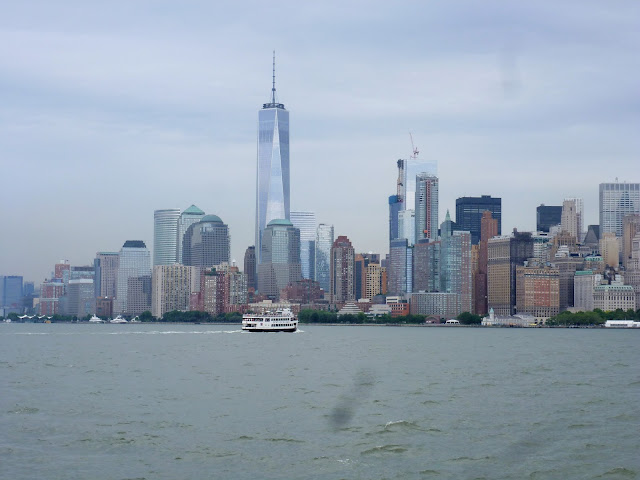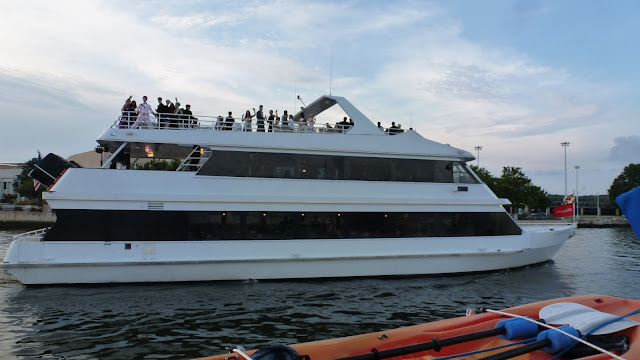From Croton-on-the-Hudson’s Half Moon Bay Marina, we rented
a car and drove to Wallkill for a barbeque at the home of Marian and Jim, my
sister and her new hubby. My nephew
Michael picked up my mom from New Windsor – a mini family reunion. It was a fun time re-meeting all the people
who I had met at the April wedding and since forgotten!
 |
| Marian and Mom |
 |
| Jim and Marian |
 |
| Approaching Bear Mountain Bridge and Anthony's Nose |
 |
| U.S. Military Academy West Point |
 |
| Bannerman Island |
The following day we continued up the Hudson to an anchorage
behind Pollepel Island, also known as Bannerman Island. Frank Bannerman became the world’s largest
buyer of surplus military equipment and his store in Brooklyn occupied an
entire block. As his accumulation of
equipment, ammunition and very volatile black powder grew, Mr. Bannerman had to
look outside the city for storage. In
1900 he purchased the island as a storage site and shortly thereafter began
construction of a simulated Scottish castle as the warehouse. Time has not been kind to the small rocky
island – vandalism, neglect, decay and fires in 1920 and 1969 destroyed much of
the structures leaving only a small portion of the exterior walls standing.
The island was easy to spot and we dropped anchor without
any problem. It was Father’s Day so
there was plenty of boat traffic on the river and the anchorage afforded no
protection from the wakes of speed boaters and jet skiers. But the worst was yet to come. I had commented upon our arrival that the air
was “so calm and a good breeze would certainly be appreciated.” I got my wish and so much more as the wind
suddenly started to blow from the south at 20 MPH!!! That was not in the forecast and definitely
not in my plan for the evening. We were
buffeted for hours before the winds calmed near midnight. The winds combined with the whistles from the
commuter trains barreling along the eastern shore of the river did not make for
a peaceful evening.
Moving right along up the Hudson we stopped next at Hyde
Park Marina. From there it was a 20
minute walk to the campus of the CIA – Culinary Institute of America – where
2,300 students study the culinary, baking and pastry arts. We enjoyed a late lunch at Apple Pie Bakery
Café, the only one of the four student-staffed restaurants open for business
this Monday afternoon. It was tough
deciding what main dish to choose from their menu (the quiche of the day won
there) but dessert was even tougher as each offering was tantalizingly
showcased. But I am happy to report that the key lime éclair was delicious!
 |
| The CIA from the water |
Tug boat traffic along this stretch of the Hudson kept Lazy W rockin’ and rollin’ through the
night. Paul, the Dockmaster at Hyde Park
Marina, indicated that much of that traffic relates to the Tappan Zee Bridge construction
as building materials are moving between Albany and the bridge via tug and
barge. We stayed at the dock for much of
the morning waiting for the tide to change in our favor and waiting for the
captain to repack the port shaft.
 |
| Esopus Meadows Lighthouse |
 |
| Rock face north of Kingston |
 |
| Near Saugerties |
Next stop – the friendly Coeymans Landing Marina. Along the way we once again made contact with
Bev and Larry on Canadian Flyer as
they slowly made their way north near Saugerties. Thanks to the rising tide, we managed to
cruise at well over 9 knots most of the way to Coeymans!
This is Rip Van Winkle country! His legend is almost as big as that of Henry
Hudson. Written by Washington Irving in
1819, Rip Van Winkle is the enchanting tale of hen-pecked Rip who
wanders into the Catskills to escape his nagging wife for the day. He soon encounters the ghosts of Hudson’s
crew playing a game of ninepin. After
drinking some of their magic potion, Rip falls into a deep slumber lasting 20
years. He even sleeps through the
American Revolution. When he awakens, he
finds his way back to his village only to find that it is unrecognizable and,
to the villagers, so is he. Rip is
eventually reunited with his children and is accepted by the villagers despite
all his eccentricities.
To enter Coeymans Landing Marina, one must carefully
navigate through an extremely narrow channel paralleling the river. This channel leads you to the fuel dock where
we would be fueling up, pumping out and tying up for the night. After securing Lazy W it was determined that she would have to be turned around so
that all the hoses and paraphernalia on the dock would reach her
connections. Seriously, do a U-turn in
the channel that is not much wider than our boat?! The dockhands told us not to worry, they do
this all the time. So we did as we were
instructed – throwing stern lines to two dockhands while another jumped in his
dinghy and nudged our bow away from the dock.
Sure enough Lazy W spun lazily
around, pivoting around the stern line grasped by the dockhands. I was impressed. Had the dockhands not done
this maneuver, we would have had to do it on our own the next morning as,
unbeknownst to us at docking time, this channel was one-way!
 |
| It was a chilly day on the water |
The bucolic countryside hugging the Hudson abruptly changes
to industrial/commercial as the trees are replaced with massive tanks and
unsightly piers at the port of Albany.
We had looked forward to stopping for a day at Troy Town Dock but it had
sustained some major storm damage a few years ago and was still not fully
operational so we pushed onward to the Federal Lock – the first of many to
come. With fenders and lines
strategically placed around Lazy W’s
starboard side, we entered the lock, I grabbed a bollard, the gate was closed
behind us and we floated uneventfully up fourteen feet. Lazy W seems
somewhat large for two people to handle in the locks (the Captain strongly disagrees
with me on this) and I fondly thought back to our 2002 cruise through here on
our 37-foot Mainship Sea Venture with
Rich Wills and 9-year-old Bryan as added crew.
In 1817 construction began on the Erie Canal. This massive undertaking was New York Governor
Dewitt Clinton’s dream or, as others derisively called it, “Clinton’s big
ditch.” Completed in 1825, this 363-mile
long canal was the first all water link between the Atlantic seaboard and the
Great Lakes. It opened a route to
settlement of the interior and countless opportunities for growth resulting in
prosperity beyond the young nation’s budding imagination. The Hudson River linked the canal to New York
City which soon surpassed Philadelphia as the nation’s chief seaport and center
of world trade. As a result, the Erie Canal has long been considered the most
influential waterway in the United States.
The original canal was 4-feet deep and 15-feet wide. It has been enlarged and rerouted several
times and is now 12-feet deep. In its
early days, horses and mules powered the system. The animals walked along the tow path,
pulling the boats along the water and inspiring the 1905 Erie Canal Song.
I’ve got a mule and
her name is Sal,
Fifteen miles on the
Erie Canal.
She’s a good old
worker and a good old pal,
Fifteen miles on the
Erie Canal.
We’ve hauled some
barges in our day
Filled with lumber,
coal and hay
And every inch of the
way we know
From Albany to
Buffalo...
 |
| Frank and Sal |
From dockside at the Waterford Visitor Center we can observe
the comings and goings of the boats entering the first lock of the Waterford
Flight of Five Locks, the start of the Erie Canal. This series of locks provides the highest
lift (169 feet) in the shortest distance (1.5 miles) of any canal built in the
United States. A bateau carrying a crew of seven reenactors gingerly rowed its
way into the lock this morning. We will
enter tomorrow.
















































